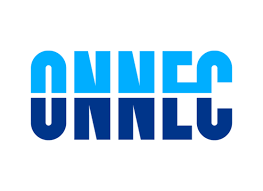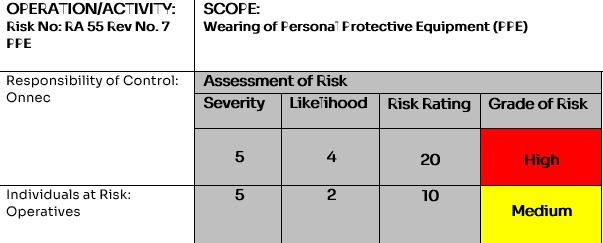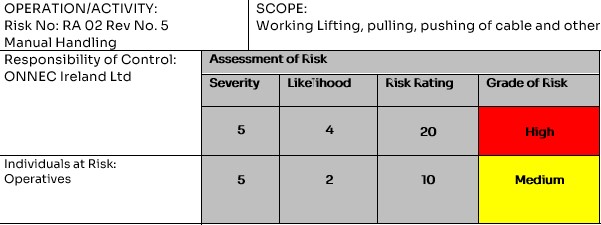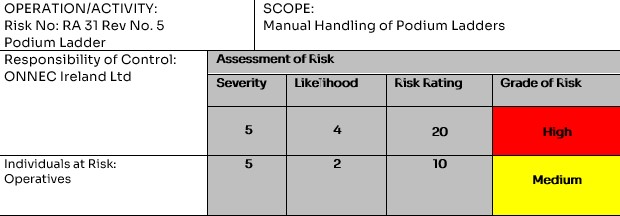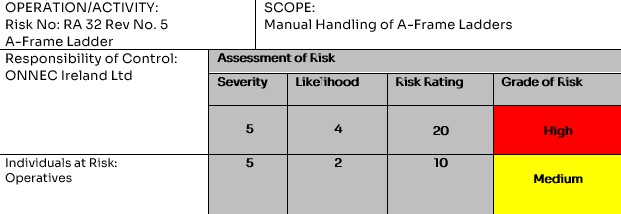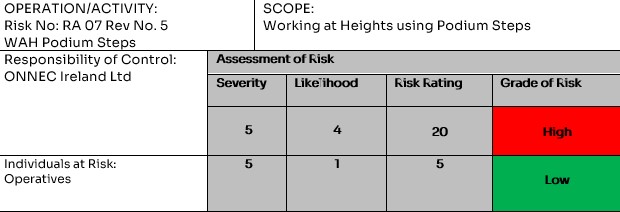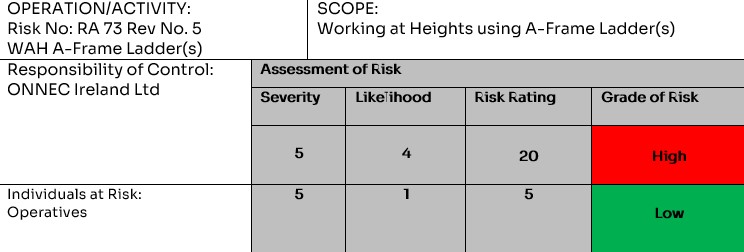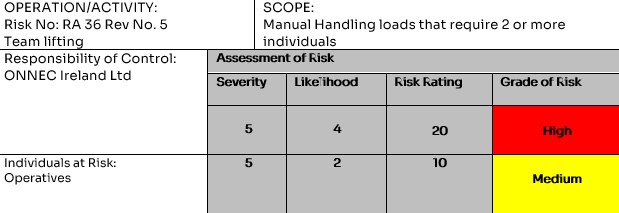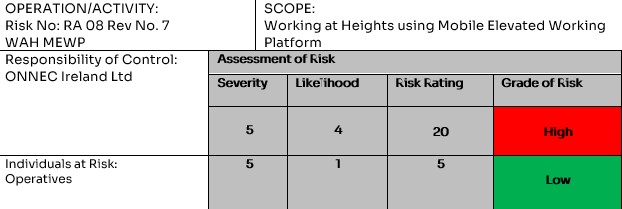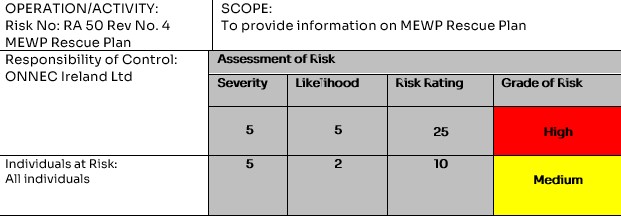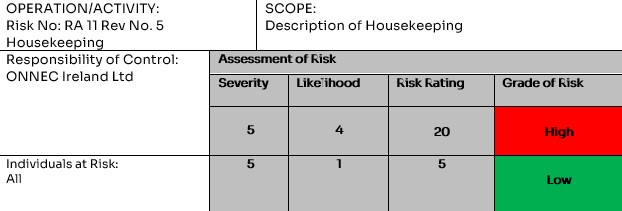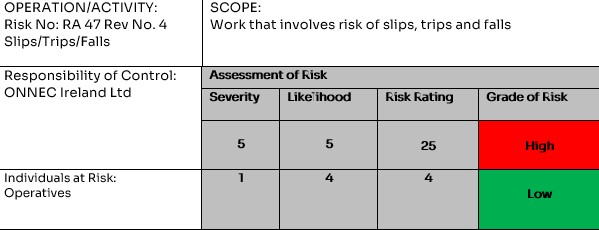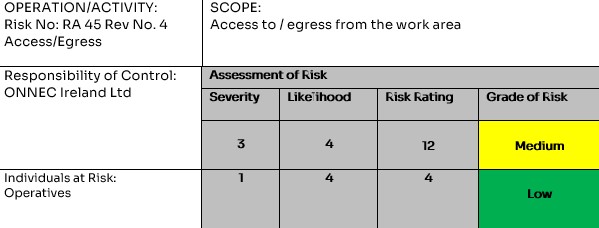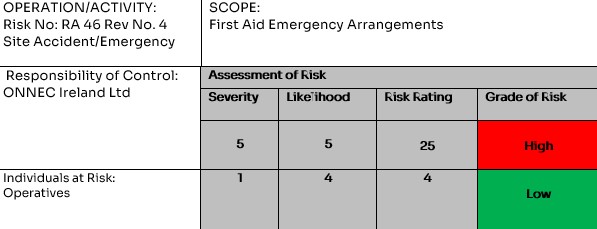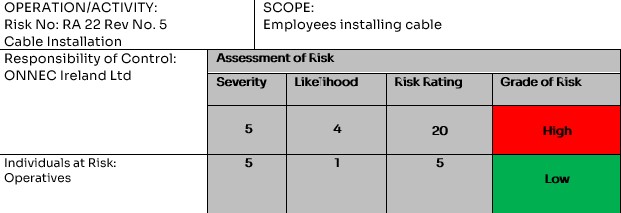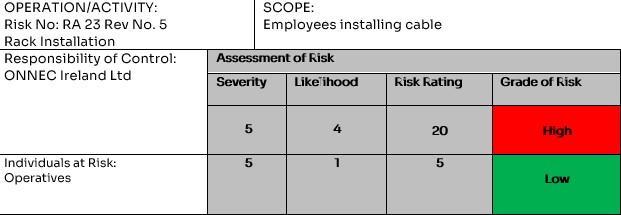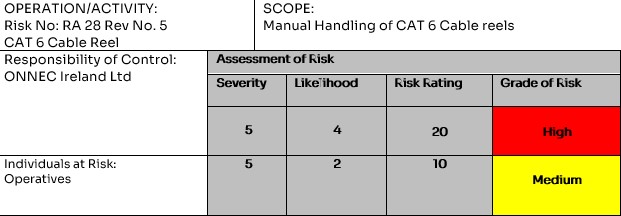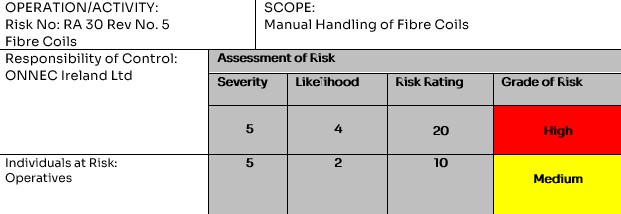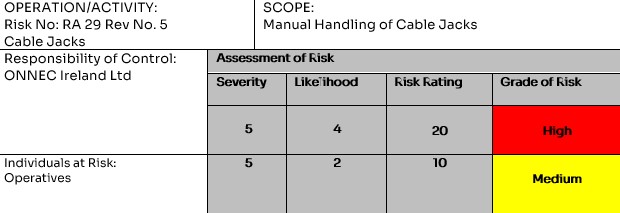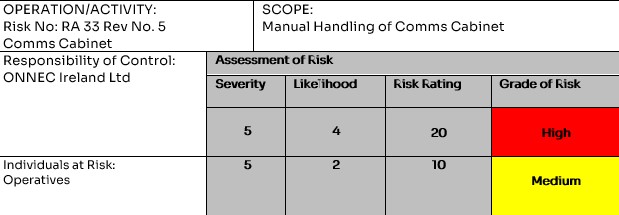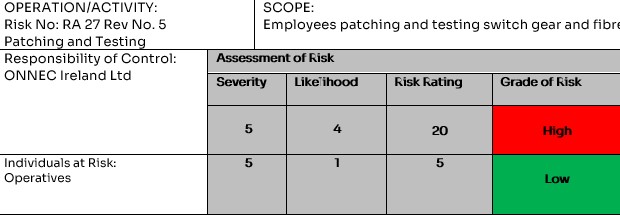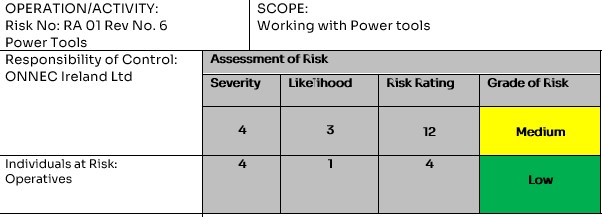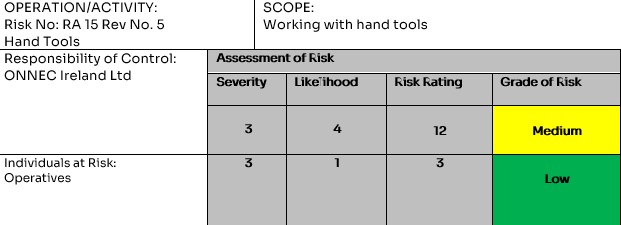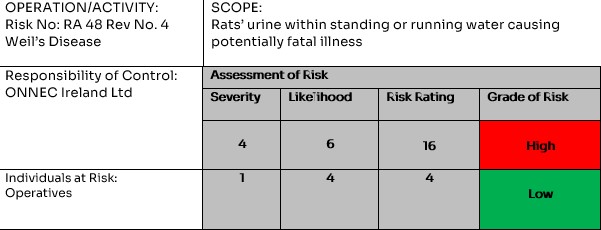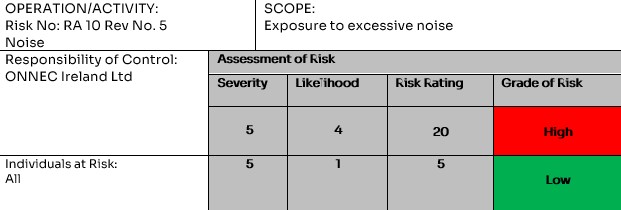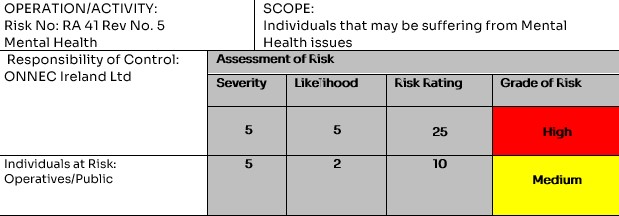Project Information
-
Rev Number
-
Project Name & Number
-
Client
-
Description of the Task/Activity
-
Location
-
Supervisor
- Ben Monaghan 0866065723
- Brian Gilbert 0866050275
- Damian Ryan 0879894659
- Don Wolfe 0868281365
- Gary Gilbert 0862600929
- Matt Flood 0851924619
- Thomas Mooney 0861304933
-
Personnel Involved
-
Start Date
-
Finish Date/PC Date
Safe System of Work
Rules and Preparations:
-
- All work will be undertaken by qualified competent persons with experience of the type of work described within this method statement, and in full accordance with safety procedures specified in the company’s Health and Safety Policy and in line with PSCS standards.
- All operatives undergo the site induction and read, understand, and sign off on this RAMS before commencement. This must be briefed by the supervisor.
- The Supervisor, technicians, trainees, and all employees will read through the RAMS and the document will be left in one location where each operative will then it to confirm they have read and understood it.
- All operatives are responsible for wearing PPE and must always wear compulsory 5-point PPE (safety glasses cut level 5 gloves, hard hat, safety boots, High Vis vest, with access to suitable face masks and full-face visors where applicable.)
- The works area and tasks need to be constantly reviewed to assess the number of people required to undertake the task with safety and health in mind.
- All operatives involved in the task will be experienced and fully trained for the work at hand, and all plant used will be fully certified and fit for use. No lone working, no exceptions.
- Day-to-day coordination will be managed at daily whiteboard meetings/pre-start-up meetings and or coordination meetings.
Items discussed will include numbers on site, proposed plan of works, deliveries, issues from the previous day, access egress, change in personnel etc. Any issues noted will be addressed by site management.
- All members of staff will respect welfare facilities in construction areas and within the accommodation building. -
Main Sequence of Work:
Completion:
-
1) Tidy Up: Deconstruct and safely store equipment.
2) Waste: Remove waste materials and place them in the appropriate waste containers/skips/recycling
3) Walk Down: Ensure the area is safe and clean. Hand the project over to the client's representative.
Organisation for H&S Control
Monitoring and Compliance:
-
Compliance will be achieved by:
- Method statement briefing
- Task briefing sheet completion by all crew members before work commences.
- Hazards and control measures identified.
- The task briefing sheet, and method statement, are to be signed off and given to the main contractor along with permits held by the operatives involved.
- Supervision by the Site Supervisor to ensure compliance with the method statement.
- Foreman or team lead ensuring permits are in place and closed off daily.
- Technicians to ensure they have signed off on the method statement and all staff permits.
- Toolbox talks held weekly.
Health & Safety Risks and Controls
-
PPE Required
- Hi-Vis Vest
- Safety Boots
- Hard Hats
- Safety Gloves
- Eye Protection
- Bump Hat
- Hearing Protection
- Respiratory Protection
-
Other PPE: Safety Harnesses, Face Coverings, Tyvek Suit
Ensure the correct gloves are used for the task.
Use Level 5 cut gloves EN388:2016 - X5XX
Fall Restraint Harness and Lanyard as required when operating MEWP (If required on-site)
Single-use PPE must be discarded hygienically after use where applicable.
Accident Procedures:
-
In the event of a serious accident occurring the procedure below must be followed. The Site Manager Safety officer and head office Safety Manager must be notified immediately. The Site Manager/ Safety Manager or other nominated persons must take charge of the proceedings as follows:
- Observe the accident location and status of the injured person.
- If there is a risk of further injury move the injured person to safety.
- Call for immediate emergency assistance and/or notify emergency service.
- See that First Aid is administered as required by a competent person.
- If an Ambulance is called, make sure the exact location (Eircode) is given and that the ambulance can access the site as near as possible to the injured person.
- Notify the Onnec General Manager, Safety Officer, head office, and Safety Representative within 1 hour of an accident occurring.
- Establish the location of the hospital and appoint a suitable person to travel with the injured party.
- Notify Onnec HR who will in turn inform the next of kin/family member of an injured person and arrange transport for them to the hospital if required.
- Gather all the information immediately about the accident and what led up to it.
- Obtain witness statements; document the information and get the witness to sign.
- Complete the accident report form along with photos and check with the safety manager and General Manager if any other information regarding the incident is required.
First Aid Boxes Locations:
-
- On-site to be confirmed. All Onnec vehicles have 1st aid boxes located under the passenger seat.
Emergency Procedure:
-
as per client induction.
Fire & Evacuation:
-
- Inform your supervisor and/or raise the alarm. Site management will contact the emergency services.<br><br>- Make your way to the nearest assembly point and await further instructions.
-
Nearest Hospital
- Beaumont Hospital, Beaumont Rd, Beaumont, Dublin PH: (01) 809 3000
- St James's Hospital, James St, Saint James, Dublin 8, D08 NHY1 PH: (01) 410 3000
- Connolly Hospital Blanchardstown, Mill Rd, Abbotstown, Dublin, D15 X40D PH: (01) 646 5000
- The Mater Hospital, Eccles St, Phibsborough, Dublin PH: (01) 803 2000
- St. Vincent's Private Hospital, Merrion Rd, Dublin 4, D04 N2E0 PH: (01) 263 8000
- Blackrock Health Hermitage Clinic, Lucan Rd Old, Fonthill, Dublin, D20 W722 PH: (01) 645 9000
- Local VHI Clinic
- Other (Please Mention in Notes)
Access/Egress
-
As per site induction
Lighting
-
Adequate site/task lighting by the main contractor
Communication
-
- Toolbox Talks
- Site Briefings
- White Board Meetings
Plant
-
What Plant is required on site?
- Test Equipment (Fluke Testers)
- Battery Drill
- 'A'Frame Ladder or Podium Ladder
- Terminating Tools
- Cable Rods
- Velcro Straps
- Copper Cable Looms
- Fibre Cable Looms
- Patch Panels
- Terminating Modules
- None (Labour Only)
Training Required
-
What Training is needed on site?
- Safe Pass
- Manual Handling
- Working @ Heights
- MEWP/IPAF
- First Aid
- Fire Marshall
Permits Required
-
What Permits are needed on site?
Waste Management
-
- All waste will be disposed of in the appropriate waste bins
- All waste that can be recycled will be in accordance with our environmental policy
- Where appropriate, if waste bins are unavailable, all waste will be brought to Onnec HQ and disposed of correctly in accordance to WEEE regulations. European Union (Waste Electrical and Electronical Equipment) Regulations 2014.
Special Control Measures
-
Are there any special control measures on site? (If 'Yes' Please Give Details in Notes)
Risk Assessments
-
Risk Assessments Associated With This Project
- 1) PPE Risk Assessment
- 2) Manual Handling Risk Assessment
- 3) Manual Handling of Podium Ladders Risk Assessment
- 4) Manual Handling of A-frame Ladders Risk Assessment
- 5) Podium Ladders Working @ Height Risk Assessment
- 6) A-Frame Ladders Working @ Height Risk Assessment
- 7) Team Lifting Risk Assessment
- 8) MEWP Working @ Height Risk Assessment
- 9) MEWP Rescue Risk Assessment
- 10) Housekeeping Risk Assessment
- 11) Slip/Trip/Falls Risk Assessment
- 12) Access & Egress Risk Assessment
- 13) Site Accidents/Emergency Risk Assessment
- 14) Cable Installation Risk Assessment
- 15) Rack Installation Risk Assessment
- 16) Cable Reels Risk Assessment
- 17) Fibre Coils Risk Assessment
- 18) Cable Jacks Risk Assessment
- 19) Comms Cabinets Risk Assessment
- 20) Patching & Testing Risk Assessment
- 21) Power Tools Risk Assessment
- 22) Hand Tools Risk Assessment
- 23) Weil’s Disease Risk Assessment
- 24) Noise Risk Assessment
- 25) Mental Health Risk Assessment
PPE Risk Assessment No: 01
-
SCOPE:
Wearing of Personal Protective Equipment (PPE)
Responsibility of Control:
Onnec Ireland
Individuals at Risk: Operatives
Risk Grade: High
Severity Likelihood Risk Rating Risk Grade
5 2 10 Medium
References:
Supporting Documents: Safety, Health and Welfare at Work Act 2005. Safety, Health and Welfare at Work (Construction) Regulations 2013
Induction, Safety Audit & Inspections
HAZARD CONTROL MEASURE/MITIGATION Additional Information
Head Protection--Hi-Vis Vests--Safety Gloves--Safety Boots--Safety Glasses--Safety Over Glasses--Hearing Protection--Fall Restraint--in Gear--Waterproof Boots.
SAFETY HELMET * - with, where applicable through risk assessment. Wear a hard hat always on site. Ensure the hat is free from cracks or damage. Do not paint or spray which will degrade the performance. Ensure hat is within 5 years of the manufacture date. Replace the hat immediately after an event where debris or objects strike the hard hat. Secure fit must be obtained, and a hard hat must not excessively wobble on the head. This can affect protection performance. No woolly hats or hoodies are to be worn under head protection. Approved balaclavas can be worn but must include ear vents.
HIGH VISIBILITY JACKETS OR VEST - Class 3 minimum. Hi-Viz is to be always worn. The wearer must regularly inspect the condition of Hi-Viz. Wash Hi-Viz garments as per manufacturer guidelines if excessively dirty or soiled. Site store to hold stock of various sizes for issue.
GLOVES TYPE AND USAGE - to be selected based on work activities BS EN 388 (gloves may be removed when using Velcro and/or working with optics but must be referenced on TBS and reviewed regularly). Cut 5 gloves to be worn when extreme cut hazards exist i.e. when working with very sharp blades.
If gloves are excessively soiled or dirty, follow cleaning guidelines or change gloves asap. Gloves are to be held in the site store for replenishment. Tasks that require handling of chemicals or oils should be carried out with suitable chem-resistant impervious gauntlet gloves. Damaged or worn gloves are to be replaced asap. The wearer must regularly check glove condition. Replace gloves after a hand injury event.
SAFETY FOOTWARE incorporating toe and midsole protection with ankle support. Boots must be inspected regularly by the wearer for wear and tear. Boots must be always worn. The wearer must order boots asap if wear and tear is excessive. Particular attention is required for laces as worn or snapped laces will affect protection due to loosely tied boots. Boots must be inspected for condition after an injury event.
PROTECTIVE EYEWARE - incorporating prescription lenses where necessary. BS EN 166 **: Optical Class 1; mechanical strength F; resistance to fogging N; Safety eyewear must always be worn. Eyewear must have anti-fog protection. Ant-fog spray must be available for anti-fog replenishment. The wearer must regularly check the condition of eyewear. If prescription eyeglasses are required, they must conform to BSEN 166 stated in bold above (or Safety Over Glasses must be worn). Glasses must be replaced after an injury or near-miss event. Site store to have replenishments for worker requirements.
•EAR FOAMS OR MUFF'S - to be used if exposed to a time-weighted average noise level of 85 decibels or higher over an 8-hour work shift. Ear foams or muffs to be used for drilling tasks. Drilling noise levels are to be known before drilling. Ear foams (EAR Classic or EAR Ultra Fit) attenuate 28dB. Earmuffs (Bilsom Viking V1) attenuate 30dB. Site store to have spares for replenishment.
Soiled contaminated muffs/foams are to be washed as per manufacturer guidance or changed.
HARNESS & LANYARDS must conform to BSEN 361 Full body harness. Visual inspection of PFPE is carried out before being issued to operatives and daily works commence. All PFPEs are to be checked and recertified as fit for ongoing use not less often than every 6 months, by a competent person. Certificates are kept on-site and regularly updated.
LANYARDS are to be visibly tagged with what capacity they are good for and the date of the next inspection. Any anchor points being utilized to operatives within the structure to have temporary works check to that effect. Setting up of exclusions zones as required for works and areas affected below. Rescue plan to be in place.
All operatives involved have full harness training, rescue training and competencies checked. Harness and lanyards should be stored in a (locked) work cage located in a secure area. When not in use, all harnesses and lanyards must be hung correctly to prevent damage (Harness - From D ring with straps untangled / Lanyard from D ring and fully extended).
Register of harness and lanyards to be kept and maintained in safety file (should include distinguishing number or mark (serial number)/manufacturer details (type/year of manufacture)/SWL)
WINTER READY PPE (for exterior works)
Rain gear should be designed and constructed for the work to be performed. Should include a waterproof jacket and trousers. Ensure correct fit to the individual. The material should be breathable. Hi-Vis to be worn over rain gear.
Waterproof boots incorporating toe and midsole protection with ankle support. Waterproof boots must be inspected regularly by the wearer for wear and tear. Waterproof boots have strong traction to prevent slips and falls in wet conditions. Weekly inspections and random checks by the EHS team and Management team shall review compliance with site rules regarding 5-point PPE. Periodic Toolbox Talks on how to wear, store and launder PPE
Manual Handling Risk Assessment No: 02
-
SCOPE:
Working Lifting, pulling, pushing of cable and other materials
Responsibility of Control:
ONNEC Ireland Ltd
Individuals at Risk: Operatives
Risk Grade: High
Control Measures:
Severity Likelihood Risk Rating Risk Grade
5 2 10 Medium
References:
Supporting Documents: Safety, Health and Welfare at Work At 2005: Safety, Health and Welfare at Work (General Application) Regulations 2007 (Amended 2012 - 2016)
Training Certs, Induction
HAZARD CONTROL MEASURE Additional Information
Back injuries--Cuts and abrasions--Slips, trips and falls--Injury from dropping a load--Sprains and strains.
Avoid manual handling where possible. Consider the Risk Factors: - Task, Individual, Load, Environment
Item to be lifted should, where practicable, be marked with its weight. Ensure people are capable of the task. Where possible give precise information on the weight of each load and the centre of gravity of the heaviest side when a package is eccentrically loaded
Awkward-shaped and heavy objects should be lifted by more than one person. A system of lifting should be engaged, and one person nominated as the leader. Lifting by manual handling should only be carried out when other means are impractical i.e. trolley, pallet truck.
Personnel should not carry items that obstruct their view. Where possible purchase products in smaller packages. Ensure ground conditions are clean, well maintained and housekeeping is in good order.
Careful selection of employees for manual handling tasks. Conduct a specific manual handling assessment for all hazardous tasks. Identify all manual handling operations undertaken by their employees. Make an initial appraisal of all operations to determine if there is a significant risk of injury to employees.
Avoid manual handling tasks that were reasonably practicable, e.g. by substituting with a sack barrow, trolley or forklift truck etc. Make a full assessment of unavoidable risky operations considering the load, task, the working environment and the individual capability of the workers.
Discuss the topic of manual handling at safety induction. Regular Safety Talks about manual handling. Gloves should be worn when lifting items with sharp objects or protrusions.
All personnel to be given adequate training and refresher training. Remove or reduce the risk of injury by implementing control measures designed to eliminate or minimise the risks of injury to the lowest level so far as reasonably practicable.
Manual Handling of Podium Ladders Risk Assessment No: 03
-
SCOPE:
Manual Handling of Podium Ladders
Responsibility of Control:
ONNEC Ireland Ltd
Individuals at Risk: Operatives
Risk Grade: High
Control Measures:
Severity Likelihood Risk Rating Risk Grade
5 2 10 Medium
References:
Supporting Documents: Safety, Health and Welfare at Work (General Application) Regulations 2007 (amended 2012 - 2016)
Training Certs, Induction, Safety Audit & Inspections
HAZARD CONTROL MEASURE Additional Information
Muscle strains and sprains of arms, back or legs--Slips Trips and Falls--Physical injuries from the load being too heavy--The load is too difficult to grasp.
Manual Handling of awkward loads should be avoided. In cases where this is not possible tasks will be planned carefully and communicated to employees. Housekeeping levels are to be kept at a high standard to reduce the risk of slips, trips and falls.
Where possible give precise information of the weight of each podium ladder and the centre of gravity of the heaviest side. Personal should not carry items that restrict their view. All staff should be trained Manual Handling technique of a team lift.
Heavy objects should not be lifted by more than one person. A team system of lifting should be engaged, and one person nominated as the leader.
The planned lift should always be considered first. MEWP should always be considered the first option before using a podium ladder. In certain cases, two persons are required to lift/carry a podium ladder. Podium ladders should be fully inspected before and after use.
Employees must assess loads using T.I.L.E. before undertaking manual handling and reduce the risk of injury as far as possible. Correct PPE is always supplied and worn. Awkward-shaped and heavy objects should be lifted by more than one person. A system of lifting should be engaged, and one person nominated as the leader. Careful selection of employees for manual handling tasks and job rotation encouraged
Manual Handling of A-Frame Ladders Risk Assessment No: 04
-
SCOPE:
Manual Handling of A-Frame Ladders
Responsibility of Control:
ONNEC Ireland Ltd
Individuals at Risk: Operatives
Risk Grade: High
Severity Likelihood Risk Rating Risk Grade
5 2 10 Medium
References:
Supporting Documents: Safety, Health and Welfare at Work (General Application) Regulations 2007 (amended 2012 - 2016)
Training Certs, Induction, Safety Audit & Inspections
HAZARD CONTROL MEASURE Additional Information
Muscle strains and sprains of arms--back or legs. --Slips Trips and Falls--Physical injuries from the load being too heavy--The load is too difficult to grasp.
Manual Handling of awkward loads should be avoided. In cases where this is not possible tasks will be planned carefully and communicated to employees. Housekeeping levels are to be kept at a high standard to reduce the risk of slips trips and falls.
Where possible give precise information of the weight of each load and the centre of gravity of the heaviest side when a package is eccentrically loaded. Personal should not carry items that restrict their view. Manual Handling of the A-Frame ladder may require more than one person, in this circumstance always get/seek assistance to move the ladder when required.
Heavy objects should be lifted by more than one person. A system of lifting should be engaged, and one person nominated as the leader. A-frame ladders should only be considered as a last resort, where podium ladders and MEWP cannot work in confined space working areas. In most cases when using an “A” Frame ladder a GA3 form will be required.
A full inspection of the “A” frame ladder must be conducted before and after use. A ladder found with a defect must be quartered and taken out of service. Never stand on either the last or second last rung of the ladder. Never overreach/stretch while working on an “A” ladder.
Employees must assess loads using T.I.L.E. before undertaking manual handling and reduce the risk of injury as far as possible. Correct PPE is always supplied and worn. Awkward-shaped and heavy objects should be lifted by more than one person. A system of lifting should be engaged, and one person nominated as the leader. Careful selection of employees for manual handling tasks and job rotation is encouraged.
Podium Steps Working @ Height Risk Assessment No: 05
-
SCOPE:
Working at Heights using Podium Steps
Responsibility of Control:
ONNEC Ireland Ltd
Individuals at Risk: Operatives
Risk Grade: High
Control Measures:
Severity Likelihood Risk Rating Risk Grade
5 1 5 Low
References:
Supporting Documents: Safety, Health and Welfare at Work At 2005
Safety, Health and Welfare at Work (General Application) Regulations 2007 (Amended 2012 - 2016)
Training Certs, Inductions, Toolbox talks
HAZARD CONTROL MEASURE/MITIGATION Additional Information
Fall from Height--Fractures--Head Injury--Permanent Disability--Fatality.
Podium steps are used and maintained in accordance with the manufacturer's instructions. Podium steps are suitable for the work to be carried out and the safe working load is never exceeded.
Podium steps are checked before use (e.g. check for splits, cracks, damaged rungs, stiles, feet, platform, steps, and locking devices), kept in good working order, reported defects are dealt with promptly and unsafe equipment is taken out of service.
Podium steps are regularly inspected by a competent person and records are kept. GA3 Forms to be used. Podium steps are used on firm-level ground with the guardrail(s) closed and the castors locked.
Podium steps are not moved with employees or materials on the platforms and climbing up the outside of the podium steps is not permitted. Podium steps are kept apart from moving vehicles and pedestrians. Work from the platform with the gate closed.
Maintain 3-point contact when climbing up and down podium steps. Tools or materials should not be carried by hand when climbing up and down steps, use tool tethers and have material handed to you by a colleague if required.
Weekly GA3 complete. Do not over-reach when using podium steps. Exclusion zones were created where possible. Ladder tags to be signed off weekly (Week ahead). when moving a podium ladder from one floor to another always have two people carrying out this task, never attempt to move the podium on your own always seek help from another staff member.
A-Frame Ladders Working @ Height Risk Assessment No: 06
-
SCOPE:
Working at Heights using A-Frame Ladder(s)
Responsibility of Control:
ONNEC Ireland Ltd
Individuals at Risk: Operatives
Risk Grade: Low
Control Measures:
Severity Likelihood Risk Rating Risk Grade
4 1 4 Low
References:
Supporting Documents: Safety, Health and Welfare at Work At 2005
Safety, Health and Welfare at Work (General Application) Regulations 2007 (Amended 2012 - 2016)
Training Certs, Inductions, Toolbox talks
HAZARD CONTROL MEASURE/MITIGATION Additional Information
Fall from Height, Fractures, Head Injury, Permanent Disability, Fatality
A-Frame ladders are used and maintained in accordance with the manufacturer's instructions.
A-Frame ladders are suitable for the work to be carried out and the safe working load is never exceeded. A-Frame ladders are checked before use (e.g. check for splits, cracks, damaged rungs, stiles, feet, steps, and locking devices), kept in good working order, reported defects are dealt with promptly and unsafe equipment is taken out of service.
A-Frame Ladder(s) are regularly inspected by a competent person and records are kept. GA3 Forms to be used.
A-Frame ladders are used on firm level ground.
Choose a ladder slightly higher than you might need to avoid overreach and follow the instructions on the ladder for safe use
Never attempt to climb onto the last two steps of the A-Frame ladderTool tethers used.
Maintain 3-point contact when climbing up and down podium steps,
Tools or material should not be carried by hand when climbing up and down steps, use tool tethers and have material handed to you if required
Ladders/steps should never be painted/defaced.
Weekly GA3 complete
Do not over-reach when using am A-Frame ladder
Exclusion zones were created where possible.
Ladder tags to be signed off weekly (Week ahead)
Team Lifting Risk Assessments No: 07
-
SCOPE:
Manual Handling loads that require 2 or more individuals
Responsibility of Control:
ONNEC Ireland Ltd
Individuals at Risk: Operatives
Risk Grade: High
Severity Likelihood Risk Rating Risk Grade
5 2 10 Medium
References:
Supporting Documents: Safety, Health and Welfare at Work (General Application) Regulations 2007 (amended 2012 - 2016)
Training Certs, Induction, Safety Audit & Inspections
HAZARD CONTROL MEASURE Additional Information
Muscle strains and sprains of arms, back or legs--Slips Trips and Falls--Physical injuries from the load being too heavy--The load is too difficult to grasp.
Incorrect communication leads to potential risk. Careful selection of employees for manual handling tasks. Choose team members of similar height and strength. Ensure the team leader is assigned to control the lift. Tasks are organised so that handling is carried out between waist and shoulder height.
Personal should not carry items that restrict their view. Correct PPE is always supplied and worn. Manual Handling and refresher training are provided to all employees. Only one person should take the lead and instruct others on when to commence lifting and lowering the load. All people involved in the lift should be trained in Manual Handling.
Decide in advance which person will direct the move. Keeping knees bent and back straight, lift and raise the load together. Move smoothly together as you carry, keeping the load at the same level. Unload at the same time, keeping knees bent.
Ensure the object is light enough to lift, steady, and unlikely to shift or move. Remove obstructions- ensure your route is clear and there is space to lower the load wherever you are planning on moving it.
For long lifts, think about resting the load midway on a table/bench to change your grip. Will help be needed? Is there equipment that could be used to aid the lift? Do not lift or work with more than you can effortlessly manage. Employees must assess loads using T.I.L.E. before undertaking manual handling and reduce the risk of injury as far as possible.
MEWP Working @ Height Risk Assessment No: 08
-
SCOPE:
Working at Heights using Mobile Elevated Working Platform
Responsibility of Control:
ONNEC Ireland Ltd
Individuals at Risk: Operatives
Risk Grade: High
Control Measures:
Severity Likelihood Risk Rating Risk Grade
5 1 5 Low
References:
Supporting Documents: Safety, Health and Welfare at Work At 2005: Safety, Health and Welfare at Work (General Application) Regulations 2007 (Amended 2012 - 2016)
Training Certs, Inductions, Toolbox talks
HAZARD CONTROL MEASURE Additional Information
Entrapment--Overturning--Person or materials falling--Collisions--Fracture--Head injury--Permanent Disability
MEWP is used and maintained in accordance with the manufacturer's instructions. MEWP is only used by trained (in the use of the actual machine type being used) and authorised employees and the operator's manual is available.
Ground conditions and overhead obstacles are checked (e.g. the presence of overhead electricity wires, obstacles, level firm surface) and the work area is suitable for the safe operation of the machine. MEWP has received a thorough inspection by a competent person within the last 6 months (GA1 Form) and is inspected weekly and records kept.
MEWP is checked before use, reported defects are dealt with promptly and unsafe equipment is taken out of use. A harness with a 1.5m restraint lanyard (to stop the wearer from getting into a position where they could fall or be thrown from the carrier) is secured to the suitable anchor point within the MEWP.
MEWP Scissor Lift is fitted with safety devices (e.g. fixed guarding around the base of the machine; controlled descent with automatic stop point; audible alarm) to prevent crushing during descent. Flashing beacon and warning alarm(s) were fitted to the MEWP are kept in good working order.
Spotter in place when operator is moving MEWP from location to location. The spotter must have appropriate training to operate MEWP in case of emergency. Electric MEWPs should be charged in well-ventilated areas.
Report of Thorough Examination and Form GA2 - Report of Weekly Examination are complete. Exclusion zones to be created where possible. Rescue procedures are in place.
MEWP Rescue Risk Assessment No: 09
-
SCOPE:
To provide information on the MEWP Rescue Plan
Responsibility of Control:
ONNEC Ireland Ltd
Individuals at Risk: All individuals
Risk Grade: High
Severity Likelihood Risk Rating Risk Grade
5 2 10 Medium
References:
Supporting Documents: Safety, Health and Welfare at Work At 2005. Safety, Health and Welfare at Work (General Application) Regulations 2007 (Amended 2012 - 2016)
Training, Induction
HAZARD/EMERGENCY SITUATION PROPOSED ACTION
Failure of upper control functions while elevated. Where the normal upper control functions fail, the operator will use the upper auxiliary controls to lower the platform safely. Failure of the operator to be able to operate the MEWP functions while elevated due to one of the following reasons. Operator incapacitated.
Auxiliary functions fail to operate from the upper control station. Where the operator is incapable of lowering the raised platform using the upper controls, an appointed person familiarised in the use of the ground’ controls will lower the platform safely using the normal ground controls.
Failure of normal ground controls. Where the normal ground controls fail, an appointed person familiarised in the use of the ‘ground’ controls will use the ground auxiliary controls to safely lower the platform. Failure of ALL normal and auxiliary lowering functions. Where all normal and auxiliary functions have failed, a competent and authorised service engineer should be contacted
CONSIDERATION FOR MID-AIR RESCUE
A mid-air, platform to platform rescue should only be considered in exceptional circumstances and only after: All normal and auxiliary lowering procedures have been attempted and the platform cannot be lowered. Site management have contacted the appropriate service technician listed in the rescue plan, to report failure of normal and auxiliary lowering systems and request servicing assistance.
If the service technician is unable to affect a timely repair to allow the machine to be brought to the ground safely site management should be contacted for permission to carry out mid-air rescue. Or where the service technician assistance is not readily available and an immediate risk exists to the health and safety of any of the occupants from remaining in the MEWP until a technician can arrive, then site management should be contacted for authorisation to carry out mid-air rescue.
WHERE SHOULD THE RESCUE PLAN BE KEPT?
The most important issue is to communicate the rescue plan. However, in the event of a larger number of personnel on site it may be necessary to display the rescue plan and keep it in plain view - on site where personnel are aware of its location.
WHO IS INVOLVED IN A RESCUE PLAN?
All site-based personnel should be involved in looking after the wellbeing of personnel on a site and should know who to report an incident to. The site manager/supervisor, operator, nominated ground personnel
Should all be aware of the rescue plan and where necessary practice the plan. The rescue plan should be reviewed with all personnel exposed to the risk of working at height and those supervising and managing the same work at height.
Nominated Personnel – person or persons assigned to be able to perform an emergency lower using either the ground controls or ground-based emergency lower control –this person should be briefed on the use of the ground controls (both normal and auxiliary) OR receive specific training as required for this task.
Housekeeping Risk Assessment No: 10
-
SCOPE:
Description of Housekeeping
Responsibility of Control:
ONNEC Ireland Ltd
Individuals at Risk: All
Risk Grade: High
Control Measures:
Severity Likelihood Risk Rating Risk Grade
5 1 5 Low
References:
Supporting Documents: Safety Health and Welfare at Work Act 2005: Induction, Safety Audit
HAZARD CONTROL MEASURE Additional Information
Slips Trips and Falls--Access and Egress areas being obstructed.
Risk of Fire--Falling Objects.
The floor must be always kept free from clutter. Floors are to be kept clean and free from liquid. A high standard of housekeeping with a clean-as-you-go policy in place. Employees will be encouraged to always keep their area clean and tidy.
Fire exits and firefighting equipment must never be obstructed. Management will comply with the requirements concerning fire as outlined in this safety statement. Cardboard is not permitted in core areas and MDFs (unbox materials away from this area and use plastic bins). Reducing slips, trips & falls can be attributed to good housekeeping.
All spillages are to be dealt with immediately. Employees are trained in the causes of dermatitis. Safety data sheets are made available to employees when working with products which could cause dermatitis. Personal protection equipment is made available to employees when working with products which could cause dermatitis.
Clean as you go policy to be always adhered to. Where facilities are in place to do so, follow waste segregation protocols.
Slip/Trip & Falls Risk Assessment No: 11
-
SCOPE:
Work that involves risk of slips, trips and falls
Responsibility of Control:
ONNEC Ireland Ltd
Individuals at Risk: Operatives
Risk Grade: High
Severity Likelihood Risk Rating Risk Grade
1 4 4 Low
References:
Supporting Documents: Safety, Health and Welfare at Work At 2005. Safety, Health and Welfare at Work (General Application) Regulations 2007 (Amended 2012 - 2016)
Training certs Induction H&S Audits
HAZARD CONTROL MEASURE/MITIGATION Additional Information
Slips Trips and Falls--Risk of cuts and bruising injuries--Back and musculoskeletal injuries may occur from lifting and carrying.
Work areas must be always kept free from clutter. Work area to be kept clean and free from liquid. A high standard of housekeeping and tidiness will be always maintained. Employees will be encouraged to always keep their area clean and tidy. Adequate Lighting must be provided when work is being carried out after dark or inside buildings.
All extension leads, electrical cables etc must be suspended safely in areas and are not to obstruct access/egress etc. Used only designated walkways to prevent slips, trips and falls. For indoor slip resistance, choose a shoe with a well-defined tread pattern and a flexible sole.
Keeping walkways through the workplace clear – no trailing cables, no obstructions. Tidy as you go – don’t leave tidying up until the end of the shift. Keep floors and access routes clear. Dispose of packing material and other wrappings carefully. Do not leave them lying around the floor.
Additional caution should be taken if blue booties are required in areas. Remove if necessary. Available Resources: Competent and Co-operative staff, advice from external specialists. Cooperation from employees, a high level of co-operation is required. Vigilance from employees as to dangers from slips, trips and falls.
Access & Egress Risk Assessment No: 12
-
SCOPE:
Access to / egress from the work area
Responsibility of Control:
ONNEC Ireland Ltd
Individuals at Risk: Operatives/Public
Risk Grade: Medium
Severity Likelihood Risk Rating Risk Grade
1 4 4 Low
References:
Safety, Health and Welfare at Work At 2005
Safety, Health and Welfare at Work (General Application) Regulations 2007 (Amended 2012 - 2016)
Training certs Induction H&S Audits
HAZARD CONTROL MEASURE Additional Information
Obstruction of emergency access/egress routes. Variations to established access/egress points. Transfer of site waste onto pavements or roadways. Slips, trips and falls from pavement/road surface. Harm to the environment. Harm to animals. Unauthorized access. Personal Injury
Procedures in place for the parking of delivery vehicles in and around the site. A dedicated pedestrian access/egress route was established from the site perimeter to the compound. Physical barriers are to be installed to prevent access to unauthorized. or dangerous areas. Signs and notices in place set out standards and controls. Never block access and egress routes with material and equipment. Clean always as-you-go policy in place. Unauthorized personnel are to be kept away from areas where work is taking place. Ensure the area of work is secured and that barriers are in place to ensure no unauthorized access. Never use unauthorised walkways for access/egress. Always use walkways that have plenty of light in the dark.
All workers were made aware of the controls during the Toolbox talk brief, including the significance of signs and notices, safety-critical areas and activities, safety restrictions and disciplinary procedures. Unauthorized entry to the working area is to be reported to site management. No work is to take place where other contractors are stationed.
Site Accidents / Emergency Risk Assessment No: 13
-
SCOPE:
Site Accidents/Emergency
Responsibility of Control:
ONNEC Ireland Ltd
Individuals at Risk: Operatives
Risk Grade: High
Severity Likelihood Risk Rating Risk Grade
1 4 4 Low
References:
Supporting Documents: Safety, Health and Welfare at Work Act 2005
Safety, Health and Welfare at Work (General Application) Regulations 2007 (Amended 2012 - 2016)
Training Certs, Induction, Safety Audits
HAZARD CONTROL MEASURE/MITIGATION Additional Information
Employee unaware of emergency numbers--No first aiders on site--No Stretcher on-site--Emergency vehicle access/egress unavailable--Inadequate supervision of the workplace--Inadequate firefighting facilities--Inadequate supervision
Untrained Operatives. An adequate number of trained first aiders are on site. Safe working systems to include first-aid arrangements. Special arrangements for confined spaces. An appointed person to inspect and maintain all first aid equipment.
Management to record all accidents. Client emergency controls are to be reflected in emergency numbers. All site personnel are to be trained in the use of fire extinguishers. Adequate supervision of the workplace. Emergency access and egress points are always kept clear.
Experienced and suitably trained person to supply and install firefighting equipment to offices and services yearly. All office staff are to receive a toolbox talk on the use of fire extinguishers. All site personnel are to be trained for the task which they are employed to undertake. Site inductions and toolbox talks were given to all employed on the site.
A Buddy System to be used and a rescue plan in place. At no time should individuals work on their own. Always maintain radio contact with other teams. Induction training to highlight emergency response – First Aid Points etc. Evacuate to assembly points which will be outlined at inductions
Cable Installation Risk Assessment No: 14
-
SCOPE:
Employees installing cable
Responsibility of Control:
ONNEC Ireland Ltd
Individuals at Risk: Operatives
Risk Grade: High
Control Measures:
Severity Likelihood Risk Rating Risk Grade
5 1 5 Low
References:
Supporting Documents: Safety, Health and Welfare at Work (General Application) Regulations 2007 (amended 2012 - 2016)
Training Certs, Induction, Safety Audit
HAZARD CONTROL MEASURE Additional Information
Access & Egress--Working in adverse weather conditions--Entanglement--Electricity--Falling objects--Falls from height--Housekeeping--Manual Handling--Entrapment--Hazardous substances--Fire
All areas of the plant require a comprehensive Permit to work form for all jobs undertaken onsite. Access and egress to each working area will be by roadways, fixed walkways, and platforms at each process plant area. Access and egress to the individual working areas will be from the platform or will be by one of the safe working at height methods described in the working at height section.
PPE in the form of warm clothing, good quality safety boots, water-proof exterior clothing. Ability to postpone jobs in extreme weather conditions i.e. high winds, torrential rain when working at height. Only qualified and competent persons to work on electrical equipment.
Permanent metal toe boards on process plant working platforms and on MEWP’s. Items secured when being transported in a MEWP basket. Cables to be positioned and secured where they will not cause a trip hazard. Operators trained and competent in Manual Handling
Trained and competent operators holding a certificate for Driving and operating MEWPS. Podium ladders to be used for W@H activities. A frame ladders are only permitted where Podium ladders are not accessible to the work area and permits to work have been completed.
Good housekeeping across the whole plant. Driver to always use harness when driving on-site or when working from MEWP basket at height. No sources of ignition to be used or taken on to plant areas without a valid Work Permit for the task. Responsibly dispose of all generated waste by using licensed contractors to remove all waste such as cables.
Rack Installation Risk Assessment No: 15
-
SCOPE:
Employees installing Racks
Responsibility of Control:
ONNEC Ireland Ltd
Individuals at Risk: Operatives
Risk Grade: High
Control Measures:
Severity Likelihood Risk Rating Risk Grade
5 1 5 Low
References:
Supporting Documents: Safety, Health and Welfare at Work (General Application) Regulations 2007 (amended 2012 - 2016)
Training Certs, Induction, Safety Audit, Manufacturing Manuals
HAZARD CONTROL MEASURE
Slips, trips and falls--Pinch--W@H--Manual Handling--Falling objects--Housekeeping
Manual handling training to be given to all staff. All staff are trained to maintain good housekeeping standards and ensure stock does not project into gangways. Warning signs to be erect where applicable. Staff report any damage to the racking immediately.
Adhere to PPE-level requirements for rack installation. All staff are to be given working @ height training. All staff is given strict instructions never to climb racking – monitored by supervisors. PPE in the form of warm clothing, good quality safety boots, High-Vis, Gloves (cut 5) Hard Hat & safety Glasses.
Ability to postpone jobs in extreme weather conditions i.e. high winds, and torrential rain when working at height. Only qualified and competent persons to work on electrical equipment. Permanent metal toe boards on process plant working platforms and on MEWPs. Items are secured when being transported in a MEWP basket.
Cables are to be positioned and secured where they will not cause a trip hazard. Operators trained and competent in Manual Handling. Trained and competent operators holding a certificate for Driving and operating MEWPS if required. Podium ladders to be used for W@H activities. A frame ladders are only permitted where Podium ladder is not accessible to the work area and permits to work have been completed.
Cable Reel Risk Assessment No: 16
-
SCOPE:
Manual Handling of CAT 6 Cable Reels
Responsibility of Control:
ONNEC Ireland Ltd
Individuals at Risk: Operatives
Risk Grade: High
Control Measures:
Severity Likelihood Risk Rating Risk Grade
5 2 10 Medium
References:
Supporting Documents: Safety, Health and Welfare at Work (General Application) Regulations 2007 (amended 2012 - 2016)
Training Certs, Induction, Safety Audit & Inspections
HAZARD CONTROL MEASURE Additional Information
Muscle strains and sprains of arms, back or legs--Slips Trips and Falls--Physical injuries from the load being too heavy--The load is too difficult to grasp.
Manual Handling of awkward loads should be avoided. In cases where this is not possible tasks will be planned carefully and communicated to employees. Housekeeping to be of a high standard to reduce the risks of slips, trips and falls.
Pallet trucks/trolleys are to be used to transport heavy or bulky loads to the workplace and should be readily available for use. The equipment will be in serviceable condition.
Where possible give precise information of the weight of each load and the centre of gravity of the heaviest side when a package is eccentrically loaded. Personal should not carry items that restrict their view. Manual Handling and refresher training are provided to all employees.
Careful selection of employees for manual handling tasks and rotation should be encouraged. C6 cable weighs approximately 11kg. C6A cable weighs approximately 18 kg. For safety reasons, it is recommended to carry a Cat-6 box cable, one in each hand. For Cat-6A it is recommended to carry just one box because it weighs 18 kg.
Depending on the location that these cat-6 reels need to be brought to, it is recommended that the further the distance you must travel with the reels the more rest you take in between moving these to the location. Employees must assess loads using T.I.L.E. before undertaking manual handling and reduce the risk of injury as far as possible.
Correct PPE is always supplied and worn. Awkward-shaped and heavy objects should be lifted by more than one person. A system of lifting should be engaged, and one person nominated as the leader.
Fibre Coils Manual Handling Risk Assessment No: 17
-
SCOPE:
Manual Handling of Fibre Coils
Responsibility of Control:
ONNEC Ireland Ltd
Individuals at Risk: Operatives
Risk Grade: High
Control Measures:
Severity Likelihood Risk Rating Risk Grade
5 2 10 Medium
References:
Supporting Documents: Safety, Health and Welfare at Work (General Application) Regulations 2007 (amended 2012 - 2016)
Training Certs, Induction, Safety Audit & Inspections
HAZARD CONTROL MEASURE Additional Information
Muscle strains and sprains of arms, back or legs--Slips Trips and Falls--Physical injuries from the load being too heavy--The load is too difficult to grasp.
Manual Handling of awkward loads should be avoided. In cases where this is not possible tasks will be planned carefully and communicated to employees. Housekeeping levels are to be kept at a high standard to reduce the risk of slips trips and falls. Mechanical Aids are used to transport heavy or bulky loads to the workplace. Equipment will be readily available and in a serviceable condition.
Where heavy loads are repeated the following must be considered: 1 / 2 lifts per minute reduce weight by 30%. 5 / 8 lifts per minute reduce weight by 50%. < 12 lifts per minute reduce weight by 80%. Where possible give precise information on the weight of each load and the centre of gravity of the heaviest side when a package is eccentrically loaded
Personal should not carry items that restrict their view. Manual Handling and refresher training are provided to all employees. Heavy objects should be lifted by more than one person. A system of lifting should be engaged, and one person nominated as the leader.
Employees must assess loads using T.I.L.E. before undertaking manual handling and reduce the risk of injury as far as possible. Correct PPE is always supplied and worn. Awkward-shaped and heavy objects should be lifted by more than one person. A system of lifting should be engaged, and one person nominated as the leader. Careful selection of employees for manual handling tasks and job rotation is encouraged.
Cable Jacks Risk Assessment No: 18
-
SCOPE:
Manual Handling of Cable Jacks
Responsibility of Control:
ONNEC Ireland Ltd
Individuals at Risk: Operatives
Risk Grade: High
Control Measures:
Severity Likelihood Risk Rating Risk Grade
5 2 10 Medium
References:
Supporting Documents: Safety, Health and Welfare at Work (General Application) Regulations 2007 (amended 2012 - 2016)
Training Certs, Induction, Safety Audit & Inspections
HAZARD CONTROL MEASURE Additional Information
Muscle strains and sprains of arms, back or legs--Slips Trips and Falls--Physical injuries from the load being too heavy--The load is too difficult to grasp.
Manual Handling of awkward loads should be avoided. In cases where this is not possible tasks will be planned carefully and communicated to employees. Housekeeping to be of a high standard to reduce the risks of slips, trips and falls. Personal should not carry items that restrict their view.
Manual Handling and refresher training are provided to all employees. Careful selection of employees for manual handling tasks and rotation should be encouraged. Cable jacks come in various sizes i.e. 1.5ton & 3Ton.
Identify those jobs involving frequent prolonged rapid forceful movements, forceful gripping and twisting movements of the hand and arm, where the wrist is angled towards the little finger, the arm held above the shoulder height or uncomfortably away from the body, and where repetitive pushing, pulling and lifting are necessary
Provide those involved in the work with information relating to the risks and ensure that operators using tools and equipment are trained in their correct use. Never use this equipment if you are ill, feeling tired, or under the influence of alcohol or drugs.
Only person(s) who are trained in the handling of these items should be allowed to handle this equipment. Employees must assess loads using T.I.L.E. before undertaking manual handling and reduce the risk of injury as far as possible. Correct PPE is always supplied and worn. Awkward-shaped and heavy objects should be lifted by more than one person. A system of lifting should be engaged, and one person nominated as the leader.
Comms Cabinets Risk Assessment No: 19
-
SCOPE:
Manual Handling of Comms Cabinet
Responsibility of Control:
ONNEC Ireland Ltd
Individuals at Risk: Operatives
Risk Grade: High
Severity Likelihood Risk Rating Risk Grade
5 2 10 Medium
References:
Supporting Documents: Safety, Health and Welfare at Work (General Application) Regulations 2007 (amended 2012 - 2016)
Training Certs, Induction, Safety Audit & Inspections
HAZARD CONTROL MEASURE Additional Information
Muscle strains and sprains of arms, back or legs--Slips Trips and Falls--Physical injuries from the load being too heavy--The load is too difficult to grasp.
Manual Handling of awkward loads should be avoided. In cases where this is not possible tasks will be planned carefully and communicated to employees. Housekeeping levels are to be kept at a high standard to reduce the risk of slips trips and falls. Mechanical Aids are used to transport heavy or bulky loads to the workplace. Equipment will be readily available and in a serviceable condition.
Where heavy loads are repeated the following must be considered:
* 1 / 2 lifts per minute reduce weight by 30%
* 5 / 8 lifts per minute reduce weight by 50%
* < 12 lifts per minute reduce weight by 80%
Where possible give precise information of the weight of each load and the centre of gravity of the heaviest side when a package is eccentrically loaded. Personal should not carry items that restrict their view. Manual Handling and refresher training are provided to all employees.
Heavy objects should be lifted by more than one person. A system of lifting should be engaged, and one person nominated as the leader. Consider splitting the load into smaller more manageable loads. Cabinets should be reduced to it lightest load possible before manual handling commences. Only trained and qualified personnel should attempt to lift this Cabinet unit(s)
Employees must assess loads using T.I.L.E before undertaking manual handling and reduce the risk of injury as far as possible.
Correct PPE is always supplied and worn. Awkward-shaped and heavy objects should be lifted by more than one person. A system of lifting should be engaged, and one person nominated as the leader. Careful selection of employees for manual handling tasks and job rotation is encouraged.
Patching & Testing Risk Assessment No: 20
-
SCOPE:
Employees patching and testing switch gear and fibre hop’s
Responsibility of Control:
ONNEC Ireland Ltd
Individuals at Risk: Operatives
Risk Grade: High
Control Measures:
Severity Likelihood Risk Rating Risk Grade
5 1 5 Low
References:
Supporting Documents: Safety, Health and Welfare at Work (General Application) Regulations 2007 (amended 2012 - 2016)
Training Certs, Induction, Safety Audit, Manufacturing Manual
HAZARD CONTROL MEASURE
Additional Information
Manual Handling--Eye Strain--Ergonomics--Working at Height--Slips trips fall--Housekeeping
Manual handling training to be given to all staff. Tables and chairs will be provided to operatives. Ensure adequate supervision is given to ensure that manual handling and ergonomic techniques are adhered to.
Only trained personnel to operate the tester. Correct PPE levels are always adhered to (safety glasses can be removed when testing (if an exclusion zone can be created) as the testing apparatus can cause blurred vision). Clean as you go policy in place.
Frequent breaks will be encouraged to ensure operatives do not obtain eye strain. Podium steps which are serviceable and identifiable off a GA3 will be used to gain access to height. All portable appliances will have a quarterly PAT test.
Power Tools Risk Assessment No: 21
-
SCOPE:
Working with Power tools
Responsibility of Control:
ONNEC Ireland Ltd
Individuals at Risk: Operatives
Risk Grade: Medium
Control Measures:
Severity Likelihood Risk Rating Risk Grade
4 1 4 Low
References:
Supporting Documents: Safety, Health and Welfare at Work At 2005: Safety, Health and Welfare at Work (General Application) Regulations 2007 (Amended 2012 - 2016)
Training Certs, Induction, Manufacture Operator Manual
HAZARD CONTROL MEASURE/MITIGATION Additional Information
Burns--Entanglement--Fractures--Lacerations--Amputations
Power hand tools are used and maintained following the manufacturer's manual and safety devices are in good working order. The tool is disconnected from its power supply before cleaning, clearing blockages or other maintenance/repair work starts. Tool adjustments are not made while moving parts are in motion.
Employees are trained in the correct use of the power hand tools and the operator's manuals are available. Sufficient clear workspace is provided, and workpieces are secured (e.g. using clamps, and jigs) where necessary. Loose clothing, jewellery, and unsecured long hair are avoided when using power hand tools. PPE (Personal Protective Equipment e.g. eye/face and hearing protection.) is provided and worn when required.
Electrical hand tools of greater than 110 volts are not used on construction sites or in damp locations. Portable electrical tools that could be subject to wear and tear are inspected and tested regularly by a competent person. Ensure power tools are tethered when working at height. Visual checks are carried out as follows:
Tools/appliance: On/off switch is working correctly - No signs of damage to casing - No loose parts or missing screws - Live parts are properly guarded so as not to be inadvertently accessible. Ensure equipment is disconnected when not in use.
Tools are checked (e.g. guards and covers in place, tools and hoses/leads in good condition with no visible damage/faults, etc.) before use, reported defects are dealt with promptly and unsafe equipment is taken out of use.
PAT testing must be completed on time (every 3 months on CLN5/6 – every 12 months on CLN1/2/3) by trained personnel.
Securely anchored to the plug with no signs of cuts, frays, brittleness, leads kinked or coiled, taped joints, overloading (overheating indicated by colour change or smell), cable cores not externally visible. Plug Securely anchored, with no sign of cracked casing, overheating, or loose or bent pins Socket outlet. No cracks or damage or signs of overheating
Hand Tools Risk Assessments No: 22
-
SCOPE:
Working with hand tools
Responsibility of Control:
ONNEC Ireland Ltd
Individuals at Risk: Operatives
Risk Grade: Medium
Control Measures:
Severity Likelihood Risk Rating Risk Grade
3 1 3 Low
References:
Supporting Documents: Safety Health and Welfare at Work Act 2005
Manufacturer Manual, Training Certs, Induction
HAZARD CONTROL MEASURE Additional Information
Cuts--Contusion--Pinch--Laceration.
Hand tools are checked before use, reported defects are dealt with promptly and unsafe equipment is taken out of use. Employees are informed of the possible risks when using hand tools. Adequate lighting is available.
PPE (Personal protective equipment e.g. gloves, eye protection) is provided and worn as required. Safety accessories, pouches and guards supplied with tools should be always used while tools are not in use. Hand tools should be stored in tool bags when not in use.
Only use the right tool for the job. Tools are regularly checked and damaged tools are discarded. Tools are locked away when not in use. The hammerhead is securely fixed on the shaft Shaft is in good condition.
Eye protection is worn for metal and stone working activities. Insulated handles are maintained in good condition. Any unauthorised use of hand tools is prohibited. Ensure you use the right tool for the right job.
Weil's Disease Risk Assessment No: 23
-
SCOPE:
Rats’ urine in standing or running water causes potentially fatal illness
Responsibility of Control:
ONNEC Ireland Ltd
Individuals at Risk: Operatives
Risk Grade: High
Severity Likelihood Risk Rating Risk Grade
1 4 4 Low
References:
Supporting Documents: Safety, Health and Welfare at Work At 2005. Safety, Health and Welfare at Work (General Application) Regulations 2007 (Amended 2012 - 2016)
Training certs Induction H&S Audits
HAZARD CONTROL MEASURE/MITIGATION Additional Information
Cuts/Scratches--Breaks in Skin--Stagnant Water-- Occupational Injury
Fatality. Avoid standing or running water where rats may be active. Wash hands before handling food or eating. Cover open wounds such as cuts and scratches with waterproof plasters. Always wear protective gloves. Be particularly aware of stagnant water.
Anti-bacterial Wipes will be available and used accordingly. Wash thoroughly as soon as possible once you have entered the water. Following good basic hygiene including regular handwashing and avoiding hand-to-mouth/eye etc contact. Taking rest breaks, including meals and drinks, away from the work area.
Washing cuts and grazes immediately with soap and running water Cover all cuts, abrasions and other breaks in the skin with waterproof dressings and/or gloves. Ensure before works take place that a scan of the work area is conducted. Available Resources: Competent and Co-operative staff, advice from external specialists. Cooperation from employees, a high level of co-operation is required. Toolbox talks will be conducted to inform staff of risks etc periodically
Noise Risk Assessment No: 24
-
SCOPE:
Exposure to excessive noise
Responsibility of Control:
ONNEC Ireland Ltd
Individuals at Risk: All
Risk Grade: High
Control Measures:
Severity Likelihood Risk Rating Risk Grade
5 1 5 Low
References:
H.S.A. “Guidelines to the Noise Regulations”
European Communities (Noise Emission by Equipment (Amendment) Regulations 2006: Safety, Health and Welfare at Work (General Application) Regulations 2007 (Amended 2012 - 2016)
HAZARD CONTROL MEASURE
Communication difficulty leading to instructions not being heard or misheard --Progressive noise-induced hearing loss--Limit the number of people working in a noisy area and the length of time they spend there.
Upper exposure action valve = 85dBA: Lower exposure action valve = 80dBA
Carry out risk assessment. Noise level indicators for machinery should be checked (via the manufacturer operations manual) prior to use. Measurement of the noise levels by a competent person, using calibrated appropriate tools, at suitable intervals. The sampling shall be representative of an employee’s daily personal exposure.
Try to eliminate noise – by design and layout of workplaces, reducing noise by technical means and/or the organisation of work. Consult with employees and provide information and training. Warning signs are in place beside fixed noisy equipment and are visible the amount of time people spend in noisy areas is limited.
Hearing protection (earmuffs, ear plugs) is provided if noise levels exceed 80 dB(A) The wearing of hearing protection, if noise levels exceed 85 dB(A), is supervised Information on noise levels and training on wearing of hearing protection is provided to relevant staff.
Health surveillance (hearing check or audiometric testing) by a registered medical practitioner is provided to staff who are frequently exposed to noise greater than 80 dB(A) or 85 dB(A) Records on outcomes of health surveillance provided to staff are maintained
Mental Health Risk Assessment No: 25
-
SCOPE:
Individuals that may be suffering from Mental Health issues
Responsibility of Control:
ONNEC Ireland Ltd
Individuals at Risk: Operatives/Public
Risk Grade: High
Severity Likelihood Risk Rating Risk Grade
5 2 10 Medium
References:
Supporting Documents: Safety, Health and Welfare at Work (General Application) Regulations 2007 (amended 2012 - 2016)
Mental Health Act 2001
Training Certs, Induction, Safety Audit & Inspections
HAZARD CONTROL MEASURE Additional Information
Suicidal acts--Self-harm--Drug and alcohol abuse--Physical harm
Psychological harm--Quality of life (including dignity, social and financial status) --Vulnerability (including exploitation, sexual abuse and violence from others) --Self-neglect--Violence--Intimidation/threats--Stalking/harassment--Property damage
Reckless behaviour (including driving
Introduction of mental health workshops within the Onnec Group
Mental Health First Aiders available within the Onnec Group
Ongoing training and awareness of Mental Health first aid
Mental health toolbox talks delivered to all staff. Motivational training and interviewing.
Training and refresher training given to managers to help spot early warning signs. Quarterly mental health alerts with helpline numbers. Our Employee Assistance provider has recently changed to Spectrum via Legal and General. I am pleased to inform you all that our new provider has an Irish freephone number 1800 558 899. They also have the option for you to Text, WhatsApp or message directly on their app.
In the case of a disclosure that has arisen due to a mental health difficulty interfering with the individual’s ability to do their job, we will adopt a partnership approach with the individual to explore and clarify the following: What difficulties is the person experiencing, and how is this stopping/hampering the person from doing their job?
What supports (reasonable accommodations) would be needed to “close the gap” and enable the person to be fully capable of carrying out the demands of their job?
How do we decide on reasonable accommodation, and how do we effectively and sensitively communicate that decision?
How do we effectively and sensitively implement reasonable accommodation. Have available to managers and supervisors’ numbers of the MH organisations. Have available to all personnel company EAP programme details
Briefing Record
-
Personnel Involved
-
I/We (the undersigned) have read and understood the attached method statement and will comply with the specified requirements and control measures. If there are any changes or deviations from the originally planned work activity or environment, we will seek further advice and request an amended method statement.sig
Worker Signatures -
Add signature
-
Manual Sign Off Sheet
